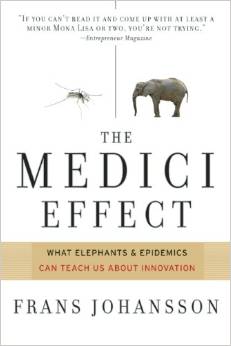Finance:The Medici Effect
 | |
| Author | Frans Johansson |
|---|---|
| Country | United States |
| Language | English |
| Published | 2004 |
| Publisher | Harvard Business School Press |
| ISBN | ISBN:1591391865 |
| OCLC | 611490724 |
The Medici Effect: Breakthrough Insights at the Intersection of Ideas, Concepts, and Cultures is a 2004 book written by United States entrepreneur Frans Johansson.[1] Published by Harvard Business School Press, it was listed as a Top 10 Business Book by Amazon.com and translated into 18 different languages.[2][3] In the book, Johansson introduced the concept of the Medici Effect, which involves innovation that happens when disciplines and ideas intersect.[4]
Summary
In the book, Johansson argues that innovation comes from diverse industries, cultures, and disciplines when they all intersect, bringing ideas from one field into another.[4] He also recommends assembling diverse teams of people to collaborate on innovation.[5]
The name of the book is derived from the Medici Dynasty, an Italian banking family that came to power in the 14th century. The family's wealth was able to support artists that led to The Renaissance.[citation needed] The book looks at examples of how Renaissance painters, sculptors, poets, philanthropists, scientists, philosophers, financiers, and architects, shaped historical eras of innovation.[6] The Medici family did not intend the Renaissance, but contributed to it with what Johansson coins as the "Medici Effect."[4]
The book became the foundation for the Medici Effect, which involves contributions of disruptive innovation from people who have no experience in an industry.[4] An example from the book includes Charles Darwin being a geologist and collecting a number of bird species from the Galápagos Islands. Darwin kept poor notes of his collection and returned the birds and notes over to John Gould upon his return.[7] Gould was an expert ornithologist and initially dismissed the birds as being normal. Gould later discovered that each species was in fact distinct.[7] The example from the book shows how Darwin, without the knowledge of ornithology, could contribute to the field without having the training or knowledge.[7]
Reception
BusinessWeek called The Medici Effect "one of the best books on innovation."[8] It was described as a "work of art" by Entrepreneur.[9] The Washington Post said that Johansson has "written a book dozens of business school professors meant to write, but couldn't."[10] Harvard Business School professor Clayton M. Christensen stated that The Medici Effect is "One of the most insightful books on innovation I have ever read."[11] The book became a best-seller and was listed as a Top 10 Business Book by Amazon.com.[3] It was also translated into 18 different languages.
Based on the success of the book, Johansson founded The Medici Group, a consultancy firm that promotes innovation through diversity.[12] He has appeared on national media and in publications that include Black Enterprise, Diversity Executive, Anderson Cooper 360°, and CNBC .[13][14][15]
Editions
The book was released in 2004 by Harvard Business School Press. The first edition of the book was called The Medici Effect: Breakthrough Insights at the Intersection of Ideas, Concepts, and Cultures.[16]
In 2006 the book was republished in paperback and Kindle format with the title The Medici Effect: What Elephants and Epidemics Can Teach Us About Innovation.[17]
On March 7, 2017 an updated edition was published in hardcover, paperback and Kindle format with the title The Medici Effect, With a New Preface and Discussion Guide: What Elephants and Epidemics Can Teach Us About Innovation.[18]
References
- ↑ Brinker, Scott (3 December 2014). "Marketing Technology Innovation Thrives In The Intersections". Marketing Land. http://marketingland.com/marketing-technology-innovation-thrives-intersections-109504. Retrieved 8 June 2015.
- ↑ "India is not leveraging the diversity it has in abundance". Society for Human Resource Management. 26 February 2013. http://www.shrm.org/pages/login.aspx?returnUrl=http%3a%2f%2fwww.shrm.org%2findia%2fhr-topics-and-strategy%2fstrategic-hrm%2fbusiness-strategy%2fpages%2f%25E2%2580%259Cindia%2520is%2520not%2520leveraging%2520the%2520diversity%2520it%2520has%2520in%2520abundance%2c%25E2%2580%259D%2520says%2520frans%2520johansson%2c%2520ceo%2c%2520medici%2520group.aspx. Retrieved 8 June 2015.
- ↑ 3.0 3.1 "Best Books of 2004 - The Top 10 Editors' Picks: Business". https://www.amazon.com/exec/obidos/tg/feature/-/546835/ref=ed_bb_bb_editors_bus?pf_rd_m=ATVPDKIKX0DER&pf_rd_s=left-1&pf_rd_r=1JRR8J3XEAZ8QT88FP0F&pf_rd_t=101&pf_rd_p=218569801&pf_rd_i=13608671. Retrieved 5 June 2015.
- ↑ 4.0 4.1 4.2 4.3 Deangelis, Stephen (January 2014). "Artificial Intelligence Set to Deliver "Wow"". Wired. https://www.wired.com/2014/01/artificial-intelligence-set-deliver-wow/. Retrieved 5 June 2015.
- ↑ Dabscheck, David (21 September 2014). "Silicon Valley needs more foxes". The Boston Globe. https://www.bostonglobe.com/opinion/2014/09/20/for-innovation-silicon-valley-needs-more-foxes/VhYrFOY43orE2VmSDQ5sNI/story.html. Retrieved 5 June 2015.
- ↑ Susco, Darlene (1 June 2015). "Debunking 5 Myths of Innovation". Business2Community. http://www.business2community.com/business-innovation/debunking-5-myths-of-innovation-01238231. Retrieved 5 June 2015.
- ↑ 7.0 7.1 7.2 "Create the Medici Effect". http://hbswk.hbs.edu/archive/4376.html. Retrieved 5 June 2015.
- ↑ Russell, Michelle (December 2012). "Don't Run From Randomness". Convene. http://www.pcma.org/convene-content/convene-article/2012/12/01/dont-run-from-randomness#.VXIwJkb0eXc. Retrieved 5 June 2015.
- ↑ Hendricks, Mark (30 November 2004). "A Work of Art - Creating a business masterpiece takes a palette of different ideas". Entrepreneur. http://www.entrepreneur.com/article/73662. Retrieved 5 June 2015.
- ↑ "Readings". The Washington Post. 17 October 2004. https://www.washingtonpost.com/wp-dyn/articles/A37482-2004Oct16.html. Retrieved 5 June 2015.
- ↑ "Join Us for a Unique Treat: Frans Johansson '95 Discusses His Book, The Click Moment". http://www.hbsanc.org/article.html?aid=1083. Retrieved 22 June 2015.
- ↑ Haislip, Alexander (4 December 2012). "Can You Succeed Through Serendipit?". Forbes. https://www.forbes.com/sites/alexanderhaislip/2012/12/04/can-you-succeed-through-serendipity/. Retrieved 5 June 2015.
- ↑ Frauenheim, Ed. "Frans Johansson: Renaissance Man". Talent Management. http://www.talentmgt.com/articles/frans-johansson-renaissance-man. Retrieved 22 June 2015.
- ↑ Alleyne, Sonia (29 January 2014). "Best-Selling Author Frans Johannsson: Why Hard Work Alone Doesn't Guarantee Success". Black Enterprise. http://www.blackenterprise.com/mag/frans-johannsson-medici-group-hard-work-success/. Retrieved 22 June 2015.
- ↑ Smith, Anderson (29 March 2009). "Anderson Cooper films CNN show at University". The Hofstra Chronicle. Archived from the original on 24 September 2015. https://web.archive.org/web/20150924030938/http://www.hofstrachronicle.com/news/view.php/488239/Anderson-Cooper-films-CNN-show-at-Univer. Retrieved 5 June 2015.
- ↑ Johansson, Frans; Johansson, Eve (2004). The Medici Effect: Breakthrough Insights at the Intersection of Ideas, Concepts, and Cultures. ISBN 1591391865.
- ↑ Johansson, Frans (2006). The Medici Effect: What Elephants and Epidemics Can Teach Us About Innovation. ISBN 1422102823.
- ↑ The Medici Effect, With a New Preface and Discussion Guide: What Elephants and Epidemics Can Teach Us About Innovation. ISBN 1633692949.
External links
 |

